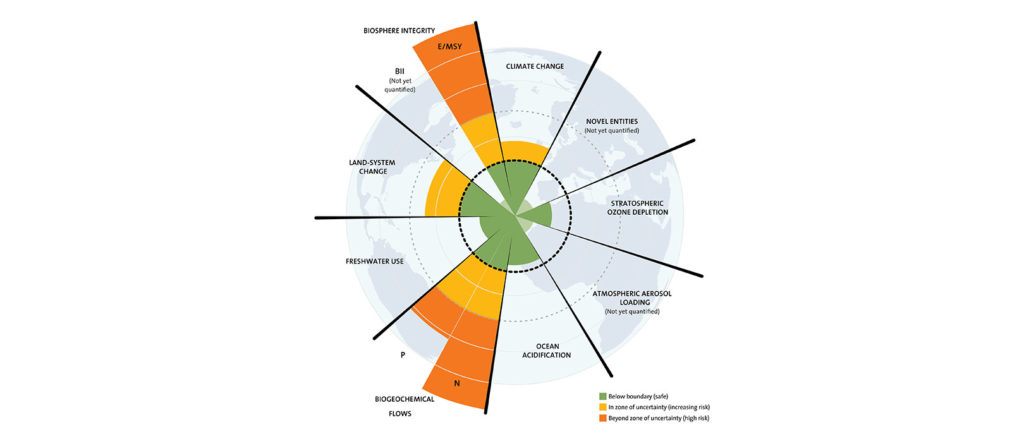Biodiversity loss and collapse – how worrying is it really? We all knew the biodiversity situation was far from good, but now we have a new hint on how alarming the situation is.
What Is Biodiversity Loss and What’s Causing It?
Anyone familiar with the Planetary Boundaries Model knows climate change isn’t the only environmental problem our planet is facing.
By looking at the image below it becomes quite evident that 4 out of the 9 systems the biosphere has to its regulation itself are at great risk. Our planet is increasingly unable to regulate the climate, hence why climate change is happening.
But the inability to regulate biogeochemical flows, land-system change, and the biosphere’s integrity are alarming too.

The biodiversity crisis, often called the 6th mass extinction, is a serious problem as a huge number of species are threatened with extinction – around 200 species go extinct every day.
This biodiversity loss is caused, directly or indirectly, by humans. And our wrongdoings are countless.
We’ve been destroying forests, habitats, and ecosystems. We’ve been harming the planet by burning fossil fuels and overexploiting natural resources. And we’ve also been widely using 1) pesticides to protect monocultural crops that have little to no natural resilience and 2) fertilizers that lead to eutrophication phenomena and soil and groundwater pollution.
An international team of evolutionary biologists, paleontologists, geologists, and modelers led by the Justus Liebig University Giessen decided to compare today’s biodiversity crisis with the previous similar one – the 5th mass extinction event. Their goal was to investigate the periods of extinction and predict recovery times for the biodiversity crisis we humans are currently causing and starting to feel.
The results are alarming – and perhaps as surpring as the environmental impact of Bitcoin.
Extinction Rate and Biodiversity Loss

The 5th great extinction was caused by an asteroid that collided with Earth in the Yucatán Peninsula in Mexico. It all happened 66 million years ago, at a time when 76% of all species on the planet went extinct, including entire animal groups like dinosaurs.
The study from Neubauer et. al. (2021), recently published in the journal Communications Earth & Environment, focused on freshwater biota – in this case, snail species – to quantify both the biodiversity loss caused by the asteroid and the rate of biodiversity recovery in the period that followed.
Put into numbers, scientists analyzed 3,387 fossil and living snail species – which are very useful to predict extinction and diversity recovery – and calculated the speed at which species come and go to predict recovery times.
Worryingly, the results suggest the extinction rate during the 5th mass extinction will be drastically overshadowed by the predicted extinction rate of the ongoing 6th mass extinction event. On average, extinction rates are 3 orders of magnitude higher now compared to the mass extinction that wiped out dinosaurs.
Moreover, according to the study’s model, one-third of all living freshwater species will have perished by 2120 if the current trends aren’t reversed.
This is leading scientists to suggest that the pace at which we are losing species today is unprecedented and has not even been reached during major extinction crises in the past.
However, the study’s scientists also warn their work was restricted to the European continent, despite evidence showing similar results worldwide. So they call out for the need for future studies that compare fossil and modern data from other continents, allowing more general predictions for biota across the globe to be made.
But there’s yet another sad story to this study.
Recovery Period: Another Biodiversity Concern

Although the cause for the 5th mass extinction was a short event – from a geological scale perspective -, the extinction rate remained high for approximately 5 million years. After this time, there was a recovery period of 6.9 million years.
Altogether, it took a little over 12 million years until the balance was restored between species originating and going extinct.
Researchers fear recovering from human-caused biodiversity loss could take even longer given the fast pace at which global change is happening today and considering the pressure Europe’s freshwater species are facing.
So it is also likely that this 6th phase of extinction will continue for several million years. Dr. Thomas A. Neubauer, the lead author of the study says that “even if our impact on the world’s biota stops today, the extinction rate will likely stay high for an extended period of time.”
This definitely opens room for a wider, deeper discussion around how we’ve been around for such a short period of time, yet “assured” the effects of our actions will outlast us by millions of years. Effects which will sooner or later come back to us since we rely on functioning freshwater environments to sustain our health, nutrition, and freshwater supplies.
[Photos by YOGESH GOSAVI, Aaron Burden and Lucas Brito on Unsplash]

